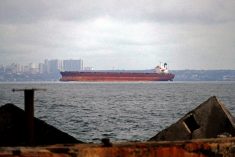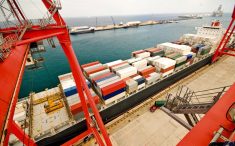A week-long strike by about 360 unionized workers on the St. Lawrence Seaway ended Monday morning with a tentative agreement on a new labour deal.
The St. Lawrence Seaway Management Corporation (SLSMC) and Unifor, the union representing the workers, announced the new agreement separately Sunday evening. Unionized workers had been on strike since just after midnight the previous Sunday.
SLSMC said Sunday it would start its “recovery program” immediately and would start passing ships “progressively” Monday as employees were due to return to work starting at 7 a.m. ET.
Read Also

U.S. grains: Soybeans bounce as Chinese demand assessed, wheat drops
Chicago soybean prices firmed on Friday in a bargain-buying bounce after a sharp fall on Thursday, as traders assessed prospects for more U.S. sales to China after the trade war truce between the countries.
Details of the proposed agreement are expected to be released once the deal passes a ratification vote. SLSMC CEO Terence Bowles said the agreement is “fair for workers and secures a strong and stable future for the Seaway.”
“For the first time in 55 years seaway workers took the very hard decision to go on strike. They did so to fight for a more respectful workplace and for an agreement that reflects today’s economic times,” Unifor national president Lana Payne said in the union’s release.
“They have shown that the best deal is reached at the bargaining table, and I congratulate the committee on their outstanding work on behalf of their members.”
Federal Labour Minister Seamus O’Regan, in a post to social media platform X on Sunday evening, thanked the SLSMC, union and federal mediators “for your commitment to the negotiating table.”
SLSMC had sought a ruling from the Canada Industrial Relations Board as to whether Seaway workers would be obligated to continue to serve bulk grain vessels, but a CIRB ruling hadn’t yet been released as of Monday morning.
The Canada Labour Code requires longshore workers to serve bulk grain ships in the event of a strike or lockout, such as during the B.C. ports strike earlier this year.
After the Seaway strike began the previous Sunday, groups such as Grain Farmers of Ontario had called on the federal government to ensure continued grain movement.
“This is a crucial time for the grain harvest in Ontario and the closure of the St. Lawrence Seaway could mean that, in a matter of days, many farmers will have nowhere to deliver grain to and we risk the grain staying on the field too long to be viable,” GFO chair Brendan Byrne had said in a release Oct. 23.
“We need governments at every level to do whatever they can to ensure the grain keeps moving. Farmers need it. Our food system needs it. Our economy needs it.”
GFO had also warned that a prolonged strike could back up grain in Western Canada, if port terminals at Thunder Bay were unable to move grain into the Seaway system before freeze-up.
“This strike served as an important reminder of the risks inherent in our export transport system and how quickly a chain reaction can be set off that will have dire consequences,” Byrne said in a separate GFO release Monday, after the tentative deal was reached.
“We urge all parties to continue working together to ensure closures of the Seaway do not happen in the future.”
Fertilizer Canada, which represents Canadian fertilizer producers and sellers, had said in a separate release Saturday that the Seaway “is less than 60 days away from closing for winter, which limits the time available to work through the backlog caused by the strike that compounds each day.”
Exports of Canadian potash were “heavily impacted” by delays from the longshore workers’ strike at the West Coast in July and had been relying on eastern ports, especially Thunder Bay, to “support recovery,” Fertilizer Canada said.
The Seaway also handles imports of fertilizer for farmers in Eastern Canada, who “have a short window to apply fertilizer and any disruption to the supply chain can threaten getting fertilizer to farmers in time and jeopardize food security,” the organization said. — Glacier FarmMedia Network















